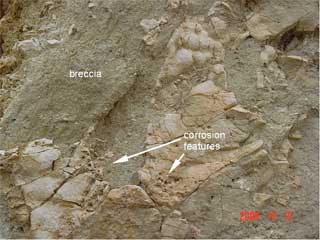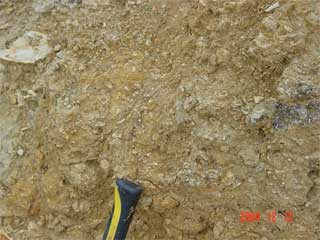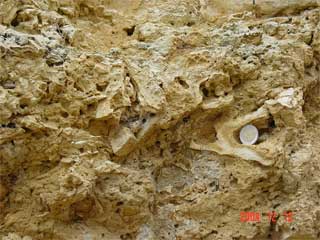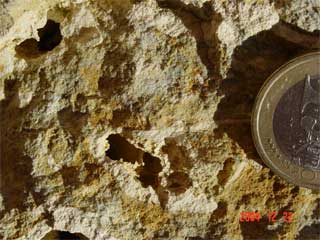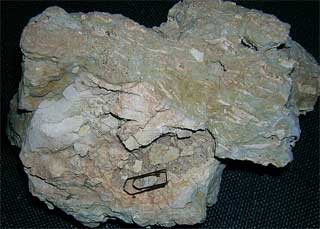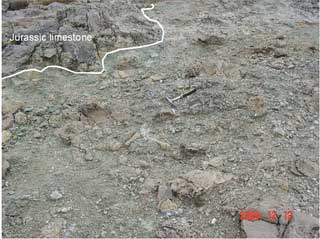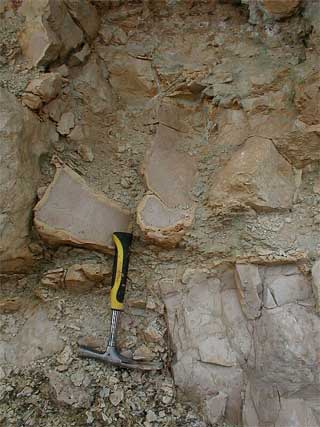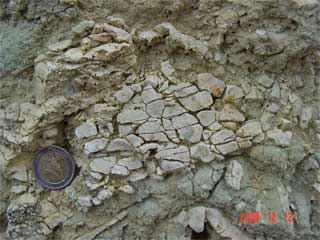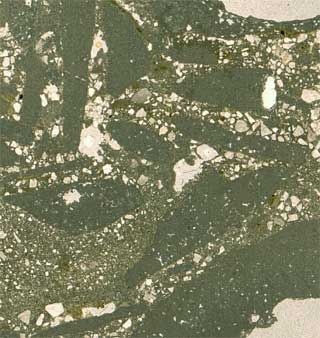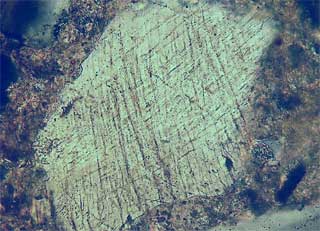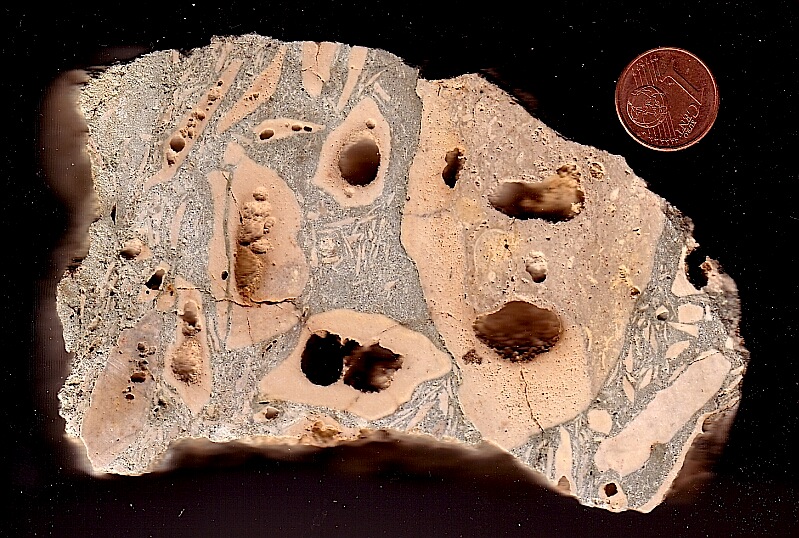About 30 km north of the center of the Azuara impact structure (Spain) near the village of Jaulín (0°59.3′ W; 41°27.2′ N), a peculiar breccia is exposed. The breccia, not mapped geologically thus far, is intercalated between fossil-rich Jurassic limestones and brownish Miocene(?) gypsum marls. The breccia is unconformably overlying the Mesozoic rocks (Fig. 1) and may penetrate the limestones (breccia dikes, Fig. 2) as well as corrode them (Fig. 3).
On cursory inspection, the greenish rock looks like a massive bone breccia (Fig. 4). On closer examination, the “bones” prove to be limestone clasts having become hollow or more or less completely skeletal (Figs.5, 6).
Beginning (Fig. 7) and complete fragmentation of the clasts is observed. Beside these decomposed clasts, fragments of the limestone host rock are intermixed in the breccia (Fig. 8). They frequently show distinct whitish rims (Fig. 9) which we interpret as the result of beginning decarbonization from enhanced temperatures. Occasionally, the fragmented clasts remain coherent giving evidence of confining pressure upon emplacement (Fig. 10). For the present, it is not clear whether the hollow and skeletal clasts originate also from the local limestones, but from the discussion below we have to assume they are allochthonous.
The clasts are immersed in a greenish matrix (Fig. 8) partly exhibiting flow texture as indicated by lined-up small elongated clasts (Fig. 7). In thin section (Fig. 11), the matrix shows to be fine-grained carbonate streaked with irregular bands of poorly rounded quartz grains in a slightly different matrix. Quite a few quartz grains exhibit planar deformation features (PDFs) as in proof of shock metamorphism (Fig. 12).
Breccia formation. – The contacts between breccia and underlying autochthonous rocks as well as the peculiar characteristics of the clasts absolutely exclude a karstification process. A “normal” sedimentation and any diagenetic processes are not consistent with the observations either. From the stratigraphic position at the base of the unfolded Upper Tertiary and from the evidence of enhanced temperatures and of shock metamorphism we conclude the breccia to be an impactite related with the formation of the Azuara structure in the giant multiple impact event that, beside the Azuara structure, formed also the large Rubielos de la Cérida impact basin and crater chain (see https://www.impact-structures.com/spain/). We explain the breccia to be impact ejecta excavated from a region in the Azuara structure where shock intensities were enough to decarbonize and melt limestone cobbles and boulders and to produce PDFs in quartz grains contributing to the breccia matrix.
Fig. 13. Breccia sample impressively exhibiting internally corroded limestone clasts. Also note the finely splintered components.
Hollow and skeletal limestone boulders, cobbles and pebbles are not uncommon in the impact region, and they have been found in e.g. the basal suevite breccia (see suevite) and the impactite from Almonacid de la Cuba (see peculiarities). The process of the decomposition obviously confined to the interior of the clasts (see especially Fig. 13) is not completely understood thus far, but we suggest two possibilities that must not exclude one another. The clasts belonged to Lower Tertiary conglomerates in the target, and they experienced
- a shock concentration in the cobbles’ interior by shock-wave reverberation and focusing effects
and/or
- a shock heating of the cobbles and a rapid external cooling upon ejection, only allowing the interior to be decarbonized and melted.
On excavation and ejection, the shocked limestone clasts were mixed with the greenish matrix material possibly originating also from the Lower Tertiary. The emplacement was a process of ballistic erosion and sedimentation (Oberbeck 1975) under high pressure (penetration into the Jurassic host rock that was partially fragmented and incorporated into the breccia) and still enhanced temperatures (partial decarbonization of the host rock).
With regard to its stratigraphical position, the Jaulín impactite must be seen as a special variety of the Azuara/Rubielos de la Cérida basal breccia, and, due to the observed shock effects and the relics of probable carbonate melt, as a special type of a suevite breccia (see IUGS classification, the_suevite_page).









































































